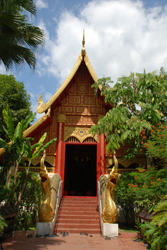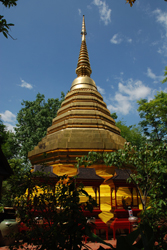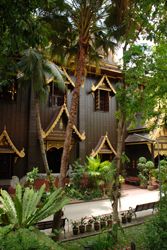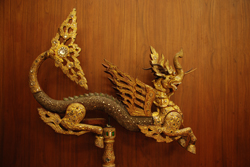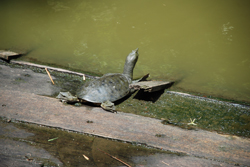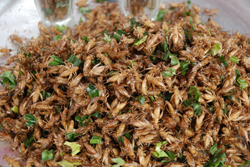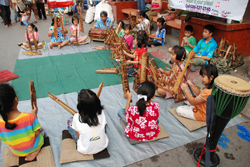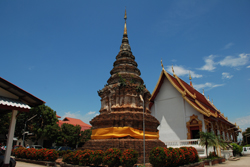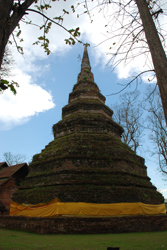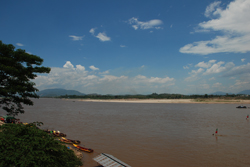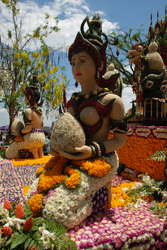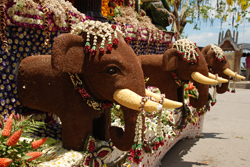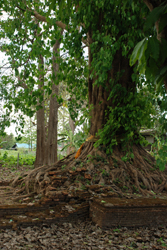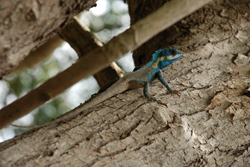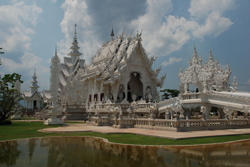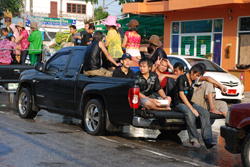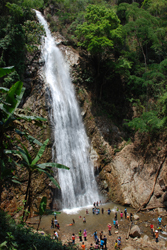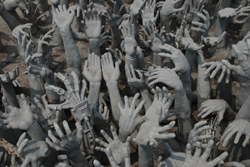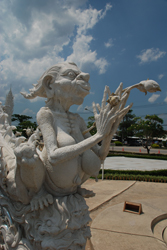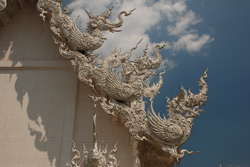Wat Phra Kaew in Chiang Rai
18 April, 2009, 03:10 am in "Thailand"
The city seems to be reverting back to normal. Shops are open and I haven't seen a single water throwing individual. There were something like 375 deaths and more than 4000 injuries/accidents during the 3 day festival period. Not surprisingly Chiang Rai province had the most. Most fatalities involved alcohol and most accidents involved motorcycles and/or speeding. The article didn't say how many were from motorcycle drivers getting a bucket of water in their face.
We finally visited Wat Phra Kaew. The wat occupies tree shaded grounds. It was once known as the Bamboo Forest from its gardens of bamboo trees. The wind rustled the leaves of the bamboo and gently rang wind chimes hanging from building eves. In a beautiful dark wooden building, decorated with gold trim, was a museum containing Buddhas and other religious items as well as some info about the various abbots of the monastery.
Young musicians
We finally visited Wat Phra Kaew. The wat occupies tree shaded grounds. It was once known as the Bamboo Forest from its gardens of bamboo trees. The wind rustled the leaves of the bamboo and gently rang wind chimes hanging from building eves. In a beautiful dark wooden building, decorated with gold trim, was a museum containing Buddhas and other religious items as well as some info about the various abbots of the monastery.
Another piece made me think of a merry-go-round creature since it was a small wooden sculpture on a pole. It was called a "Phya Luang" which is a Lanna deity which is similar to the Naga (Phya Naak). It looks like a winged dragon with an elephant's trunk and horse legs. It symbolizes male strength and power. It is believed "Luang" is from "leng" which means dragon.
After the museum, we visited the jade Buddha which replaced the "emerald" one which is now in Bangkok. The sun had heated the stairs to the pagoda and I burnt my bare feet going in. The Buddha was dressed in gold metal clothing. There were paintings on the walls of various events including some about the creation and presentation of this jade Buddha.
I found the travels of the emerald Buddha interesting since we'd visited the Phra Kaew wat in Vientiane as well. The legend says (recorded by Phra Bhrohm Rajpanya, a scholar monk in Chiang Mai, told in "Tamnan") The image was created by Phra Nagasaenthora from sacred jade sent from the God Indra and brought by angels. It was sculpted in 234 BC. It resided in the city of Patalibutra (now Ratpatana) in India. From there it went to Sri Lanka, Kampucha, Inthapat (Angkor Wat), Krung Sri Ayudhaya, Lawo (Lopburi), Vajiraprakarn (Khampaeng Phet), Wat Phra Kaew Chiang Rai (1391-1436- 45 years, Lampang (1436-1468 32 years), Chiang Mai (1468-1553 83 years, Laos 1553-1778 225 years), Bangkok 1778-present).
In 1390 AD King Mahabhrom took the image from Khampaeng Phet and hid it behind stucco inside the pagoda of wat Pa Yiah (Bamboo Garden), Chiang Rai. Lightning struck and revealed the treasure. It seems covering Buddhas in stucco and having them accidentally be "damaged" revealing a treasure in side is a common occurrance. The same thing happened to the Gold Buddha in Bangkok.
After visiting the Buddha we watched turtles basking in the sun in pools next to the pagoda, necks outstretched. Catfish would sometimes lift their whiskered heads above the murky waters.
I found the travels of the emerald Buddha interesting since we'd visited the Phra Kaew wat in Vientiane as well. The legend says (recorded by Phra Bhrohm Rajpanya, a scholar monk in Chiang Mai, told in "Tamnan") The image was created by Phra Nagasaenthora from sacred jade sent from the God Indra and brought by angels. It was sculpted in 234 BC. It resided in the city of Patalibutra (now Ratpatana) in India. From there it went to Sri Lanka, Kampucha, Inthapat (Angkor Wat), Krung Sri Ayudhaya, Lawo (Lopburi), Vajiraprakarn (Khampaeng Phet), Wat Phra Kaew Chiang Rai (1391-1436- 45 years, Lampang (1436-1468 32 years), Chiang Mai (1468-1553 83 years, Laos 1553-1778 225 years), Bangkok 1778-present).
In 1390 AD King Mahabhrom took the image from Khampaeng Phet and hid it behind stucco inside the pagoda of wat Pa Yiah (Bamboo Garden), Chiang Rai. Lightning struck and revealed the treasure. It seems covering Buddhas in stucco and having them accidentally be "damaged" revealing a treasure in side is a common occurrance. The same thing happened to the Gold Buddha in Bangkok.
After visiting the Buddha we watched turtles basking in the sun in pools next to the pagoda, necks outstretched. Catfish would sometimes lift their whiskered heads above the murky waters.
In the evening we went to the Saturday evening market which was happily water fight free. We ate at the food street choosing grilled rice balls over cricket salad. The cricket vendors had huge crates full of crickets. I guess if you do eat crickets at least you know they are fresh. We stopped for a bit to listen to a children's music group. They played bamboo instruments in the manner of a hand bell group... each child playing a particular note.
Young musicians
Chiang Saen: The Town of Stupas
17 April, 2009, 03:10 am in "Thailand"
People are still throwing water. It's Friday. I'm guessing that means it will last through the weekend. Bangkok has an excuse since the festivities got postponed due to the protests.
We decided to go visit Chiang Saen. Most tourists go to Chiang Saen to get to the Golden Triangle and Opium Museum. We don't really care about either. The Golden Triangle commands a view of Laos and Burma (I'm guessing they pretty much look the same) and a sign (now they've added a Buddha). I think we've seen enough about Opium. The reason we decided to go to Chiang Sean is in a free magazine I picked up that has illustrated maps, the one for Chiang Saen showed lots of drawings of little ruins.
We were early enough on the road that the water throwers weren't out yet. There was some traffic and once again we were stunned by the number of pickup trucks.
After we got out of the Chiang Rai sprawl, we could see rice fields and bamboo covered hills, some with stupas on top.
Chaing Saen is really littered with ruins of wats, walls, and stupas. It was attacked by the Burmese and was eventually under Burmese control. During these battles, is when, I guess, everything was destroyed. The main wat, Wat Chedi Luang, had a towering stupa. The wat's main building had been destroyed leaving low remains of brick walls. However, a wooden roof had been built to cover the area and it continued to be used as a wat
We decided to go visit Chiang Saen. Most tourists go to Chiang Saen to get to the Golden Triangle and Opium Museum. We don't really care about either. The Golden Triangle commands a view of Laos and Burma (I'm guessing they pretty much look the same) and a sign (now they've added a Buddha). I think we've seen enough about Opium. The reason we decided to go to Chiang Sean is in a free magazine I picked up that has illustrated maps, the one for Chiang Saen showed lots of drawings of little ruins.
We were early enough on the road that the water throwers weren't out yet. There was some traffic and once again we were stunned by the number of pickup trucks.
After we got out of the Chiang Rai sprawl, we could see rice fields and bamboo covered hills, some with stupas on top.
Chaing Saen is really littered with ruins of wats, walls, and stupas. It was attacked by the Burmese and was eventually under Burmese control. During these battles, is when, I guess, everything was destroyed. The main wat, Wat Chedi Luang, had a towering stupa. The wat's main building had been destroyed leaving low remains of brick walls. However, a wooden roof had been built to cover the area and it continued to be used as a wat
Chiang Saen was a lot more bustling than Chiang Rai. They had a market/festival going on. We walked past vendors to the riverside where huge speakers appeared to be broadcasting music to Laos. I remembered the loud music we heard when we were inn Vientiene and wondered if they felt Laos needed the benefit of Thailand's big speakers to broadcast music to them. There were lots more food venders on the river side.
Earlier there had probably been a parade and there was a float sitting by the side of the road. Swans and nagas were made by folding leaves and flowers in to feathers and scales and other features. There were elephants which were covered with poppy seeds. Trucks cruised around the town trying to douse people. We subtly made our way back up the main street stopping at various stupas.
Only a bit of the platform remained of "Abandoned Temple #6", but a tree had grown where the stupa had been. Someone had wrapped gold cloth around the base as they had done to the regular stupas.
We went outside the walls and walked by more stupas, and along the city walls. Then we took the bus back to Chiang Rai. The water throwers were out and hit the bus several times.
Chiang Rai: Water Flies, Waterfalls and the White Temple
16 April, 2009, 03:10 am in "Thailand"
They are still throwing water. We rented a motorbike. While within the city we got a flat tire. The pickup trucks with water warriors were beginning to emerge. It's interesting how many wear cowboy hats. That and the yelling reminds me of hicks in the US-- driving around in pickups, hollerin' and wearing cowboy hats. They also wear bright colored aloha shirts reminiscent of ugly American tourist stereotypes. What does this all mean?
We went to Khun Korn waterfall which was packed with people picnicking. The road up was a war zone. Most people honored our requests to not throw water but some didn't.
The White Temple is a very interesting building with a bit of a whimsical feeling like an ice palace or wedding cake-- all silver and white. It even had silvery white fish in the reflecting pools. There was also some odd concrete art. In front of the bridge to the wat was an area full of hands reaching up-- one was even robotic. Some had a colored nail, some had coins people had placed. Distorted goblins were on either side of the bridge with melting faces-- eyeballs hanging below. Near the pool were silver and white animals and dragons. The roof had nagas and elephant/nagas. Inside had a gold Buddha and paintings-- rose colors on gold. It was a very unique building. It was a pleasant respite from being nailed by buckets of water.
Powered by My Blog 1.69. Copyright 2003-2006 FuzzyMonkey.net.
Created by the scripting wizards at FuzzyMonkey.net..
(Code modified by Rowshan Dowlatabadi)
Created by the scripting wizards at FuzzyMonkey.net..
(Code modified by Rowshan Dowlatabadi)


